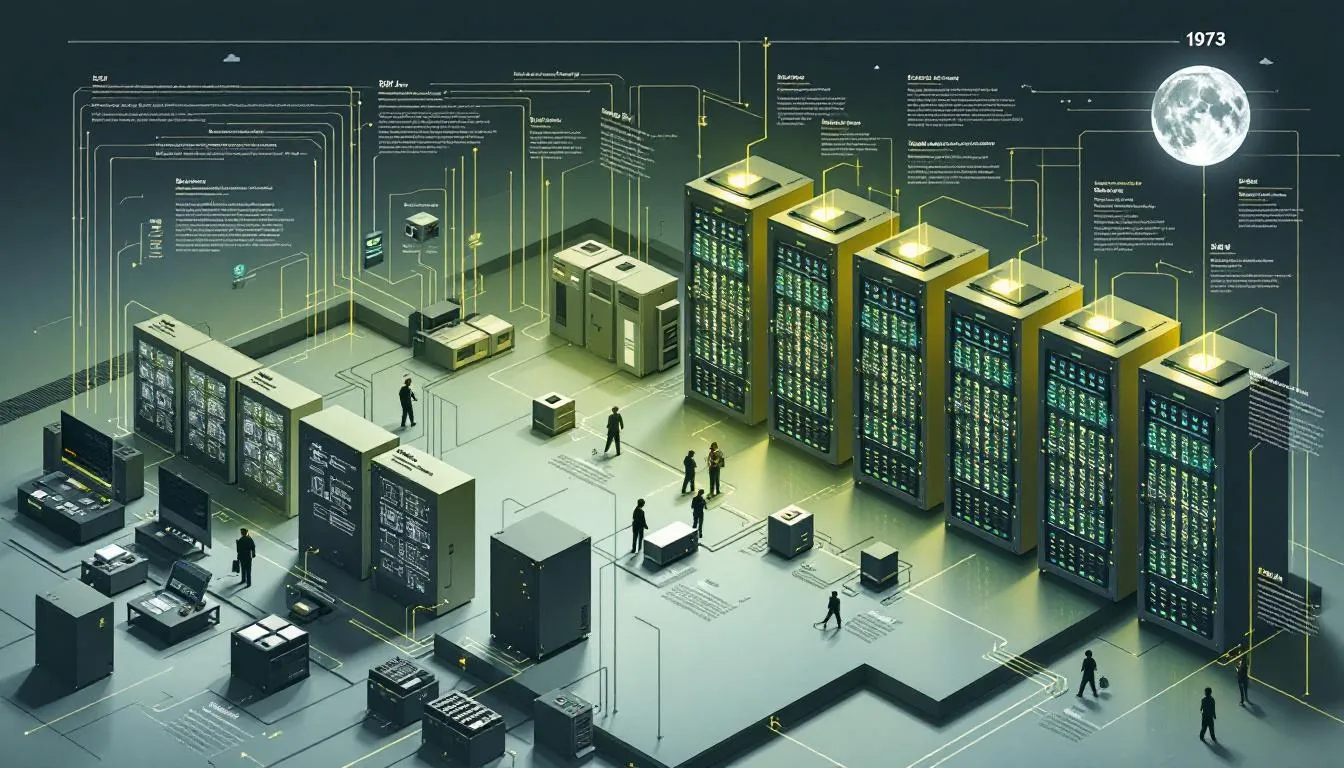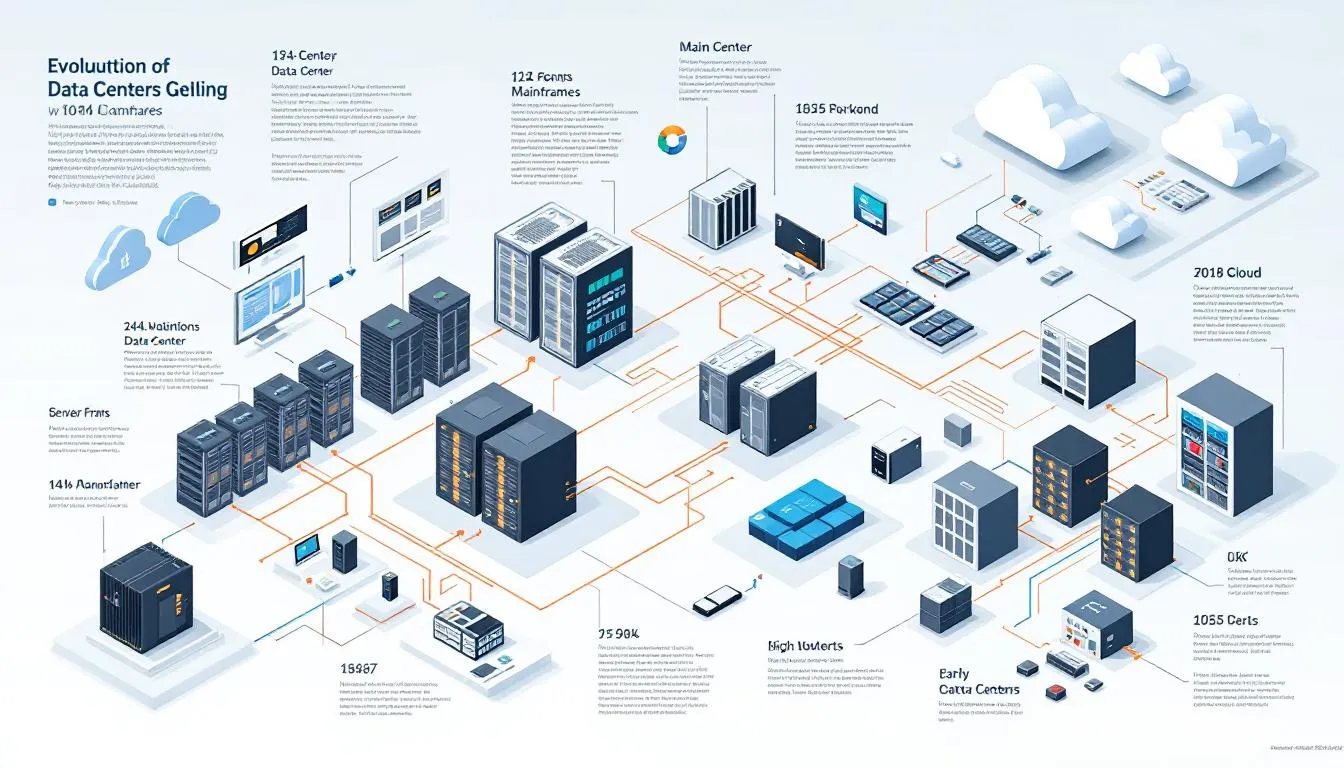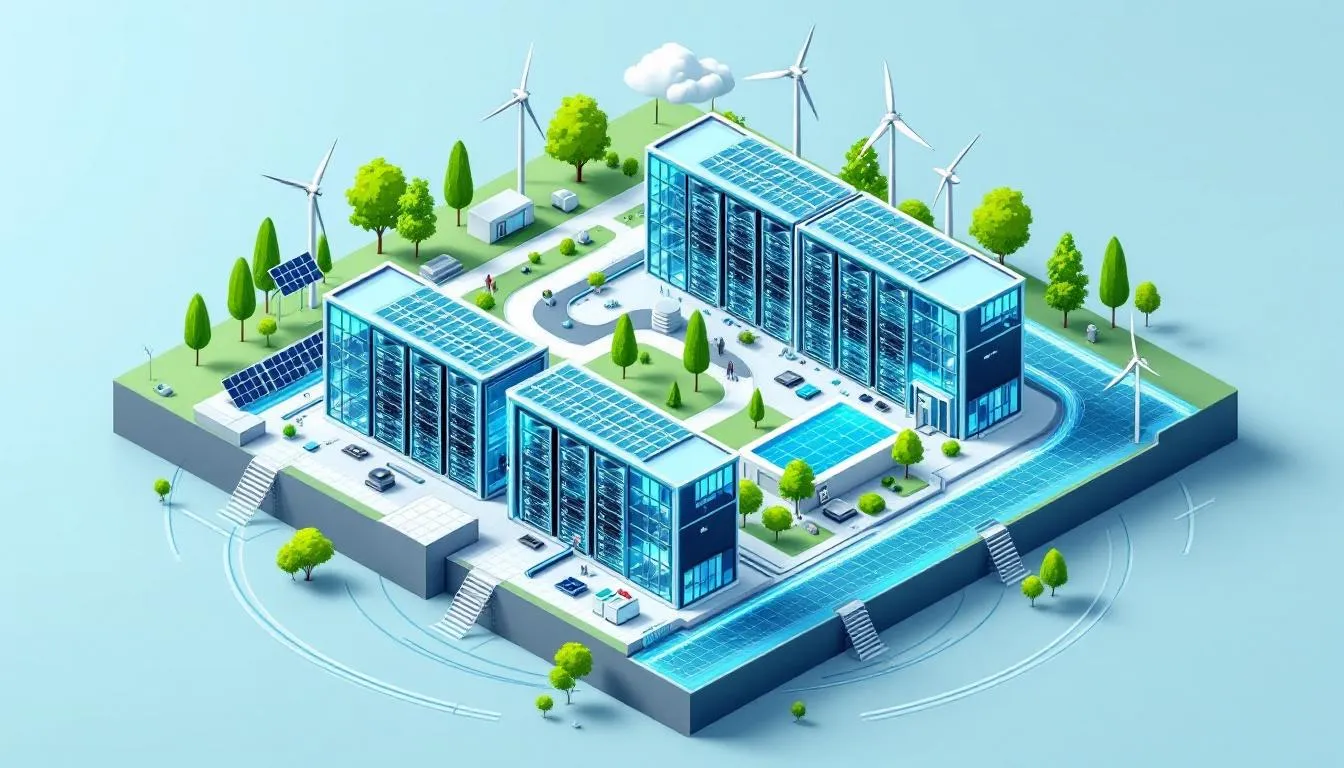The history of data centers spans decades of innovation, from massive 1950s mainframes to today’s cloud giants. Each technological breakthrough, from mainframes to the cloud, solved crucial problems and enabled new possibilities for businesses and technology. In this article, we explore the major milestones that have defined the evolution of data centers, and how these advancements continue to shape our digital world.
Key Takeaways
- Data centers evolved from centralized mainframe systems in the 1950s and 1960s to sophisticated infrastructures that incorporate advanced cooling, energy efficiency, and security measures by the modern era.
- The rise of cloud computing and the internet in the late 1990s and mid-2000s revolutionized the data center landscape, necessitating significant investments in infrastructure and leading to the growth of hyperscale data centers.
- Future trends in data centers focus on flexibility and resilience, with increased demands for AI-driven workloads, edge computing solutions, and robust security measures to safeguard against emerging threats.
Origins of Data Centers: The Early Days

The concept of data centers began to take shape in the 1950s and 1960s, marking the evolution of centralized data storage. During this period, the primary goal was to store and process critical data for decision-making. Early data centers, known as mainframes, were massive machines that processed large amounts of data offline and were not interconnected through networks. These traditional data centers required specialized environments and extensive manual management to ensure their functionality.
One of the pioneering examples of early data centers was the CDC 6600, developed in the 1960s. Recognized as one of the first supercomputers, the CDC 6600 highlighted both the cost and specialized use of early computing technology. These early data centers faced numerous operational challenges, including high power consumption and the need for constant human intervention to transport records physically for processing. Despite these challenges, the foundation was laid for the future evolution of data centers.
With the increasing importance of data centers, the demand for more efficient and reliable systems rose. This period set the stage for significant advancements in data center technology and design, paving the way for the foundational developments of the 1970s.
The 1970s: Foundational Developments
The 1970s marked a critical era in the history of data centers with the construction of the first official data center by IBM. This development led to a recognized demand for efficient mainframe computers and standardized environments. IBM’s early data centers focused on creating controlled environments to ensure optimum temperature and humidity for mainframe reliability, marking significant advancements in cooling systems.
Alongside these infrastructural advancements, the need for physical security in data centers and network infrastructure emerged as a critical consideration. Protecting these valuable assets became paramount, leading to the implementation of security measures that would evolve in complexity over the coming decades.
These foundational developments set the stage for the rapid expansion and technological advancements that would follow in the 1980s and 1990s.
The Personal Computing Boom: 1980s to 1990s
The personal computer revolution of the 1980s significantly spurred the demand for data management and storage facilities, including computer rooms. As personal computers became more prevalent, the need for data centers to support this growing usage increased dramatically. Major tech companies such as Microsoft and Apple expanded their operations during this period, driving the demand for server rooms and data centers to manage their burgeoning data needs.
The creation of database management systems during this decade further enhanced organizations’ ability to efficiently store and access large volumes of data. These storage systems revolutionized data management, allowing for more sophisticated handling of information and driving the need for more advanced data centers.
However, the limitations of on-premises setups in the 1990s led to the development of purpose-built data centers designed to meet the growing demands of the digital age. As data centers grew in complexity and capability, they laid the groundwork for the transformative impact of the internet era in the late 1990s and early 2000s.
Internet Era: Late 1990s to Early 2000s
The explosive growth of the internet during the late 1990s led to a significant increase in data storage needs as internet startups emerged, pushing internet data centers and data centers to expand quickly. Web hosting services and specialized data centers for online businesses were established to meet the business demands of an increasingly digital economy.
This era also saw the rise of colocation facilities, allowing companies to share data center space and cut costs in response to the increasing demand for resources. The late 1990s experienced a rapid rise in colocation facilities, allowing companies to share data center space and cut costs in response to the increasing demand for resources.
As businesses generated more data, the need for larger, more advanced data centers became apparent, leading to significant investments in data center infrastructure. The internet era marked a pivotal point in the data center industry, setting the stage for the revolutionary impact of cloud computing in the mid-2000s.
Cloud Computing Revolution: Mid-2000s Onward

The onset of cloud computing in the mid-2000s revolutionized access to enterprise IT by:
- Allowing businesses to rent services and enhance scalability.
- Companies like Amazon Web Services (AWS) and Microsoft Azure fundamentally changing IT infrastructure by offering flexible, pay-as-you-go pricing models for IT resources.
- Significantly reducing the initial capital required for businesses.
- Marking a pivotal moment with the introduction of AWS, which provided scalable, on-demand resources over the internet.
- Transforming business infrastructure strategies.
Cloud services enabled organizations to scale business operations swiftly in response to changing demands, enhancing agility in operations and fostering faster innovation. Businesses that adopted cloud computing gained the ability to quickly adapt to market changes and deploy applications rapidly, keeping pace with user needs on the Google Cloud Platform.
The development of hyperscale data centers by major cloud service providers was a direct response to the growing demands of the digital economy. The cloud computing revolution not only transformed the data center industry but also paved the way for modern data centers with advanced architecture and design.
Modern Data Centers: Advanced Architecture and Design
Modern data centers are essential for web hosting and cloud computing, incorporating advanced architecture and design to meet the demands of the digital age. Virtualization technologies were introduced during this period, enabling multiple virtual servers to operate on single physical servers, enhancing efficiency and resource utilization. New innovations have emerged to enhance energy efficiency in data centers. These include hot aisle/cold aisle containment, direct-to-chip liquid cooling, and AI-driven energy optimization systems.
Advanced cooling technologies maintain energy efficiency while supporting high rack capacities, ensuring that data centers can handle increasing computational loads. The integration of these advancements fosters a sustainable and flexible infrastructure in modern data centers, allowing them to continue evolving and meeting the growing demands of the digital economy.
Energy Efficiency and Sustainability Initiatives

Data centers are projected to account for approximately 1.5% of global electricity consumption and 1% of energy-related greenhouse gas emissions. As such, adopting renewable energy sources and energy-efficient technologies has become essential for data center operators looking to reduce energy consumption and their carbon footprint. Energy-efficient green data centers prioritize minimizing environmental impact through the use of renewable energy, energy consumption, and sustainable cooling technologies.
Dynamic optimization helps data centers adjust resources in real-time, maximizing performance while minimizing energy use. Key metrics for sustainability in data centers include Power Usage Effectiveness (PUE) and Carbon Emissions, which track energy efficiency and environmental impact.
As sustainability initiatives gain importance, data center design increasingly focuses on eco-friendly technologies to minimize environmental impact and meet the growing demand for environmentally responsible solutions.
The Role of Artificial Intelligence in Data Centers
The increasing integration of artificial intelligence (AI) within data centers is enhancing operational efficiency and enabling advanced predictive maintenance. AI-driven technologies, such as machine learning capabilities introduced by Microsoft Azure, help businesses analyze data efficiently, contributing to smarter decision-making.
Liquid cooling systems are emerging as a vital solution for the intense thermal demands of AI workloads. Advanced cooling analytics using real-time data help optimize temperature control in AI data centers, ensuring that they operate at peak efficiency.
AI technologies are critical for developing future-ready data centers, enhancing their sustainability, and ensuring they can optimize infrastructure to meet the demands of the modern digital economy. Digital transformation accelerates these advancements.
Edge Computing and High-Density Colocation
Edge computing enables faster data processing by bringing computation closer to data sources, essential for applications where quick decisions are crucial. Processing data at the edge reduces the need to transfer large datasets to central locations, alleviating network congestion and improving efficiency. A hybrid computing model, combining edge and centralized high-performance computing (HPC), allows organizations to optimize both speed and processing power.
High-density colocation supports AI and other high-computation workloads by providing necessary infrastructure in a compact format. This approach maximizes physical space usage by housing more compute power per square foot and reduces the total cost of ownership (TCO) through energy-efficient designs and streamlined cooling. The demand for modular data centers is increasing due to their ability to scale quickly in response to changing workload requirements.
The role of edge data centers in supporting ultra-low latency demands is crucial for real-time applications, making them an integral part of the future of data center architecture.
Future Trends: Flexibility and Resilience
Hybrid IT solutions are becoming essential for organizations to combine different cloud services and on-premises computing resources effectively. The demand for data processing driven by AI is expected to account for 70% of total data center demand by 2030, with AI workloads requiring significantly more computing power than traditional cloud computing. AI data centers necessitate more than 40kW of power per rack, significantly exceeding the 12kW typically used in conventional data centers.
AI data centres are categorized into training facilities, which develop AI models, and inference centers, which apply these models for real-time insights. Flexibility, sustainability, and resilience will be a major focus for businesses in the next decade regarding data centers.
Advancements in artificial intelligence, IoT, and big data analytics are driving the future of data centers, ensuring data centers continue to remain at the forefront of innovative technologies and technological innovation.
Data Center Security: Protecting Critical Assets

Data centers face significant risks from both cyber and physical threats, necessitating a combination of security measures:
- Physical breaches can lead to severe cyber damage, emphasizing the need for robust physical security to protect hardware.
- Insider threats are increasingly prevalent, with internal actors responsible for more data compromises than external attackers.
- As data became more valuable, organizations enhanced data center reliability by implementing redundancy measures such as backup systems.
Key components of data center security include biometric access, multi-factor authentication, and video surveillance. Visitor management software enhances security by tracking entry and exit, which helps identify unauthorized activities. Conducting periodic audits and assessments helps in identifying vulnerabilities and ensuring compliance with security standards.
Data Center Management: Ensuring Operational Efficiency

Effective management of data centers involves:
- Regular monitoring of systems to ensure optimal performance and quick identification of issues.
- Conducting risk assessments and implementing integrated physical and digital security solutions as best practices for data center security.
- Implementing standardized procedures to maintain compliance with industry regulations and enhance operational consistency.
Utilizing automation tools can significantly improve efficiency by reducing manual tasks and minimizing the risk of human error, ultimately contributing to reducing operational costs. Regular training and development programs for staff are essential to keep them updated on best practices and emerging technologies.
Effective data center management is crucial for maintaining operational costs, efficiency, security, and compliance, especially to minimize data center downtime.
Summary
The history of data centers is a testament to the incredible advancements in technology and the growing demands for data storage, processing, and management. From the early days of mainframes to the modern era of cloud computing and AI, data centers have continuously evolved to meet the needs of the digital age. As we look to the future, the focus on flexibility, sustainability, and resilience will ensure that data centers remain at the forefront of technological innovation.
Frequently Asked Questions
When did the concept of data centers first take shape?
The concept of data centers first took shape in the 1950s and 1960s, marking a significant evolution in centralized data storage.
What was one of the first supercomputers recognized as an early data center?
The CDC 6600, developed in the 1960s, was one of the first supercomputers recognized as an early data center. Its innovative design set a benchmark in computing performance at that time.
How did cloud computing revolutionize data centers?
Cloud computing has transformed data centers by enabling businesses to rent resources, which increases scalability and lowers the initial capital expenditure on hardware. This shift allows companies to be more agile and responsive to changing demands.
What are some key components of data center security?
Key components of data center security encompass biometric access control, multi-factor authentication, video surveillance, and effective visitor management software. Implementing these measures is crucial for safeguarding sensitive information and maintaining overall security integrity.
What is the significance of edge computing in data centers?
Edge computing is significant in data centers as it accelerates data processing by positioning computation near data sources, thereby facilitating rapid decision-making in critical applications.
